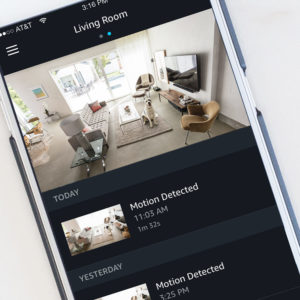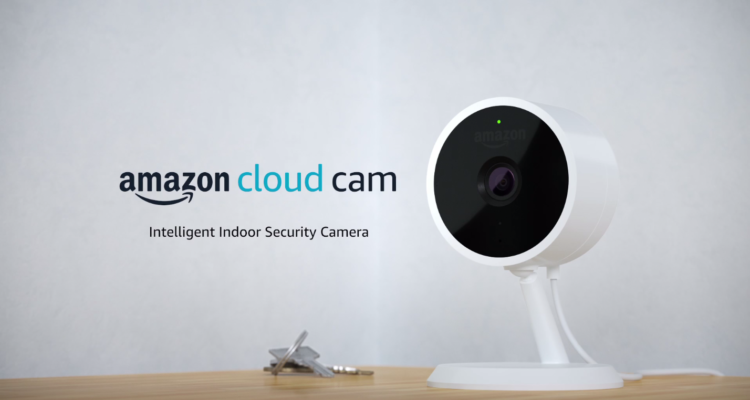With the ever popular Echo series of virtual smart assistants, Amazon has positioned themselves squarely at the top of the smart home industry. But they haven’t been content with just controlling the devices in your home, they want to make them too. And before they jumped deep into home security with the purchases of Ring and Blink, they gave us the Amazon Cloud Cam.
Priced at just $120, the Amazon’s Cloud Cam takes aim at more expensive industry players like Nest and Arlo. The aim seems to be providing all the standard features we expect with simple integration into Amazon’s ecosystem. Top it off with free use of Amazon’s cloud storage and easy access to your live feed through Fire TV or a video-screen Echo device (like the Show or Spot).
Familiar Design that’s Easy to Setup
At first glance the Amazon Cloud Cam has an uncanny resemblance to the Nest IQ. Small, white, and relatively well built (although not as solid as the Nest) while maintaining a lightweight frame. There isn’t a magnetic base, but it does come with a mounting bracket if you want to hang on a wall.
 The camera viewing angle can be adjusted manually and provides 120 degree field of view in 1080p. The swivel arm isn’t particularly smooth but does achieve the desired result. Night vision is available using it’s 8 IR LEDs along with a microphone and speaker for 2-way audio.
The camera viewing angle can be adjusted manually and provides 120 degree field of view in 1080p. The swivel arm isn’t particularly smooth but does achieve the desired result. Night vision is available using it’s 8 IR LEDs along with a microphone and speaker for 2-way audio.
There are a few misses though with the design. The lack of a local storage option through a Micro SD card is disappointing. It feels like a decision to force you into paying for their cloud storage. And while offering an ethernet port for wired internet is becoming rare in home security cameras, it is an option I like as the connection is more reliable. Unfortunately the Cloud Cam does not have that either.
Another minor gripe is an always-on green LED that sits on the front of the camera. If your plan is to use this as hidden surveillance, the bright green light draws attention to it. There is currently no way of turning this light off either. It’s an annoying design decision.
Setting up the Amazon Cloud Cam
Amazon products have been known for their easy setup and the Cloud Cam doesn’t disappoint. You’ll need to install the Amazon Cloud Cam app on either your Android or iOS device. From there, you’ll enter in your Amazon credentials.
The Cloud Cam uses Bluetooth to pair itself with the app. With my phone a few feet away, it connected within seconds and was ready to run. Between installing the app, logging in, and connecting the camera, it was a 5-minute experience.
With the camera up and running, there are a number of settings you can tweak to your liking. You’ll be able to setup how you’d like to receive notifications when the motion sensor is triggered, as well as the sensitivity of it. A feature I enjoyed was the Home/Away setting which uses your phone’s location to turn on the Cloud Cam when you’re away and off when you get home. While geofencing can be hit or miss with smart home products, it worked exceptionally well with here.
Solid 1080p Video with Minor Night Vision Issues
With crisp 1080p resolution and a 120 degree viewing angle, the Amazon Cloud Cam comes awfully close to matching Nest’s quality at a much lower price. The 30 frames per second was consistent and provided relatively smooth video in optimal light.
Night vision is where the Cloud Cam sees some drop off. Despite it’s 8 IR LEDs, it just doesn’t brighten up the room enough. It’s tough to make out items at distance and there is a bit of general cloudiness to it. This isn’t to say the night vision is bad. It’s just not at the level you find with competitors Arlo and Nest.
Standard motion detection is a little sensitive out of the box but with some tweaking in the settings it worked well. Person detection (as opposed to any motion) and setting up zones worked great but does require purchasing Amazon’s cloud service.
The two-way audio was superb. Microphones picked up whispers from across the room with ease. You’ll be able to hear if your dog’s barking or other commotion is taking place. The speaker on the other hand isn’t great (nor does it need to be) but gets the job done.
Features Buried in Paid Cloud Service
 Without a local storage option, the Amazon Cloud Cam saves your feed to their cloud storage service. And like most companies, Amazon offers a free and paid version. The free version gives you storage of 24 hours on up to 3 cameras. You can download clips, share them online, and get notifications on this plan.
Without a local storage option, the Amazon Cloud Cam saves your feed to their cloud storage service. And like most companies, Amazon offers a free and paid version. The free version gives you storage of 24 hours on up to 3 cameras. You can download clips, share them online, and get notifications on this plan.
However, the free plan removes two important features from the Cloud Cam. Person detection lets you only receive alerts when the camera detects a human being. This is great to avoid your phone going off each time the cat starts cleaning himself on the couch. The other feature is zones which allow you to turn off motion alerts on a portion of your video feed. Helpful if you find something in your camera’s line of vision triggering motion alerts (a mirror catching sunlight perhaps).
Now for many people, the Cloud Cam service is a no-brainer and this is not an issue. But it did rub me the wrong way. While I understand charging for additional cloud storage, it seems tacky to turn off advanced features already built-in to the product unless you pay a monthly fee.
There are 3 paid cloud storage options available that vary in how many days clips are stored for and how many cameras you can have running. Pricing is right around other major competitors. Amazon utilizes their AWS cloud servers so it was quick to pull up clips and never encountered downtime.
Works Great with Alexa
Amazon products tend to play well with each other so it’s not a surprise that the Cloud Cam integrates flawlessly with Alexa. If you have a Fire TV, Echo Show, or Echo Spot, you can pull up your live video feed with a voice command. This function worked great with a 5-second delay before video hit the screen.
You can setup alerts to go out through all the Echo devices in your home when motion is detected. For instance the light ring on the Echo Dot will turn green when a notification is waiting. And of course you can give the voice command (“Alexa, turn off kitchen camera”) to turn on and off your various camera.
While things work great in the Amazon ecosystem, there hasn’t been much effort outside it. For instance, Nest Cam can sync with Phillips Hue or LIFX lights to have it trigger on when motion is detected. This provides some extra security to your home when you’re away. Amazon has no outside integration at this time and no signs that is changing in the future.
Great Mid-Priced Indoor Security Camera
At $120, the Amazon Cloud Cam is a nice middle ground between high end cameras like Arlo and budget options like Wyze. Video quality is pretty good and buying the cameras in bulk tends to provide some great savings. Plus they integrate so well with existing Amazon devices.
We do wish there was a way to store clips locally. And that some of the advanced features didn’t require the paid cloud service. But if you’re someone who’s tied into the Amazon ecosystem already with Echo devices and a Fire TV, this camera will fit right in.


